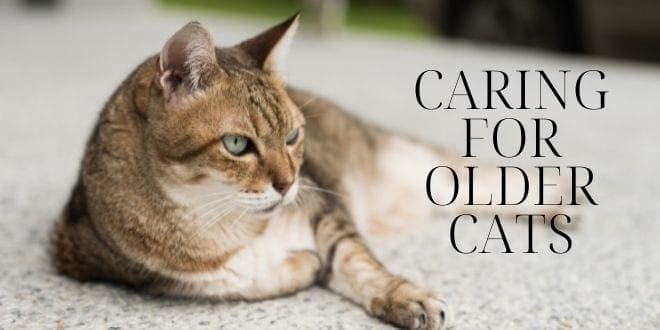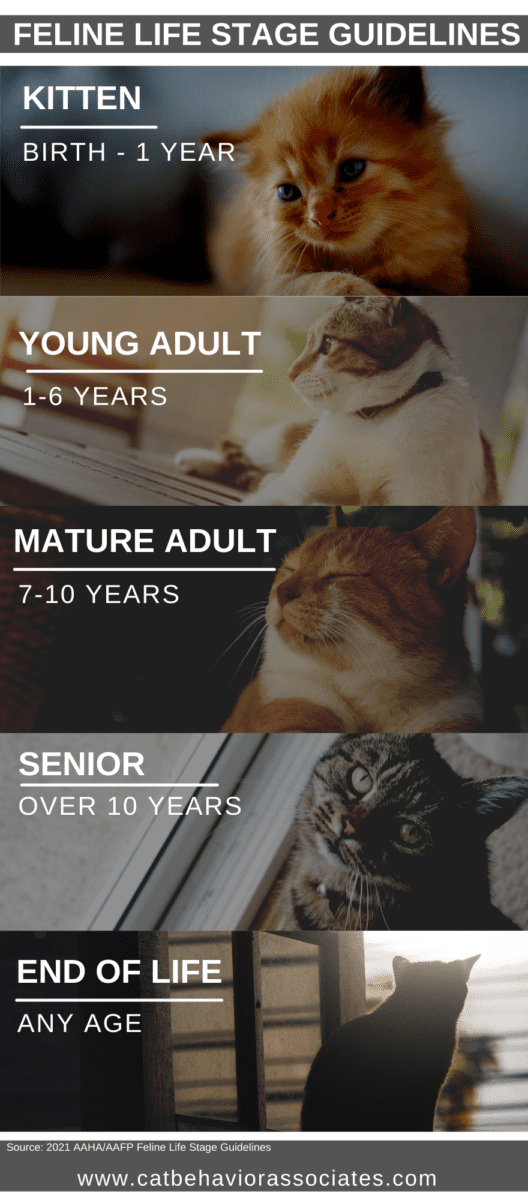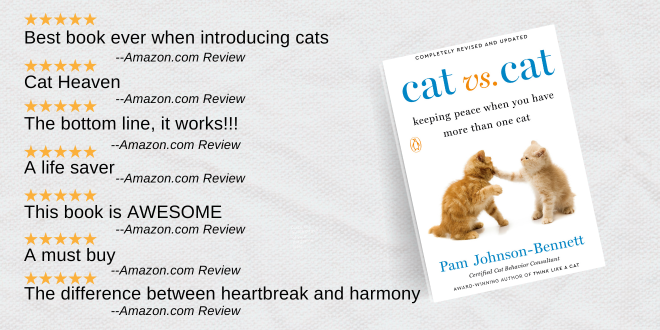
Our companion cats are living longer thanks to constant advancements in veterinary care, more awareness concerning high quality nutrition, and better attention paid to their emotional, physical, and mental needs. Every cat is unique though and age-related issues may start to show up in one cat at the age of seven while a feline housemate may not start to show age until 10. It’s important to have your cat seen by the veterinarian at least once a year so age-related problems can be detected early. If you can, twice a year is even better when your cat becomes a senior. Many veterinarians offer senior wellness packages that help reduce the cost. Once your cat reaches the geriatric years, it’s strongly recommended that twice-yearly visits be made.
Life can go along without any problems for your cat and then as she approaches senior years, you may notice changes. Don’t assume it’s just normal age-related behavior without having your cat checked by the veterinarian. Any change in behavior is a potential red flag that something medical may be brewing. Age-related issues left unaddressed can have serious consequences. Additionally, if you’re alerted to these changes early, there are things you can do to make life more comfortable for your senior feline.
The feline life stage guidelines were updated by the American Animal Hospital Association and the American Association of Feline Practitioners. A difference from the previous guidelines is that there are now four age-related stages and then an end-of-life stage (which can happen at any age). These guidelines simplify things and are in line with how cat parents tend to view their own cats’ life stages.

Your Older Cat is Going Through Changes
Changes in mobility. Physically, your senior cat may have no difficulty getting around or you may notice she is starting to struggle when it comes to reaching the places in your home she normally loves. Jumping up to a favorite window perch may take more of an effort or may be too difficult. This may be due to arthritis or degenerative joint disease. Never give aspirin to your cat for arthritis as that is highly toxic. Talk to your veterinarian if your cat is having trouble moving around or appears to have stiff or painful joints.
The Litter Box. When it comes to the litter box, a senior cat may develop arthritis, making it difficult for to get in and out. An older cat may also lack bladder control so she may not make it to the box in time. Arthritis or stiff joints can also make it difficult for the cat to get to a standing position and walk to the box in time to empty the bladder. Older cats who are diabetic or in renal failure may not make it to the box in time because of increased water intake. Constipation is another common issue with older cats. This can lead to litter box avoidance if the cat associates the box with discomfort. Your cat may also make so many attempts to poop that she winds up straining every chance she gets – no matter where she is at the time.
Appetite changes. Your older cat may gain weight due to decreased activity but increased food or may lose weight from lack of appetite. The appetite decline might be due to a decreased sense of smell, cognitive issues, disease, dental pain, etc.
Hearing decline. If your older cat has a decreased sense of hearing she may sleep more soundly and as a result, might not get the message from the brain in time that the bladder is full. A cat with declining senses may also be more easily startled.
Grooming changes. Older cats may become less fastidious about their daily grooming. The coat may start to look messy, matted and may even develop an unpleasant odor.
Dental problems. Lack of appetite, drooling, foul odor to the mouth, inflamed or very red gums are just some of the symptoms indicating periodontal disease. There may even be a foul odor to the cat’s coat from the saliva during self-grooming. Dental disease is painful and very serious as bacteria can travel from the gums into the bloodstream to vital organs.
Changes in eyes. High blood pressure can cause serious and painful changes in eyesight. It’s important to have your cat’s blood pressure checked during each veterinary visit. Older cats may also develop a hazy film over the eyes with age.
Disease. Hyperthyroidism, diabetes, renal failure, hypertension, and cancer are diseases that can happen to a cat at any age but are more commonly associated with older cats. If you notice any change in your cat’s appetite, water intake, litter box habits, behavior, vocalization, or appearance, or if your cat seems uncomfortable, it’s time to call the veterinarian. The sooner a potential disease is diagnosed, the greater the chance of successful or comfortable management. Never assume a change is just “old age.” You want your cat to have the highest quality of life.
Cognitive changes. Age-related cognitive syndrome is something you may have heard of and it can affect older cats. It can be as subtle as the cat exhibiting increased vocalization periodically to something as serious as being completely disoriented. It’s something to be aware of in case your senior cat starts displaying symptoms.
Helping Your Older Cat
If your cat’s behavior is concerning you and you think she may be experiencing cognitive dysfunction, consult with your veterinarian. There are medications available to help slow the progression. There are also environmental things you can do – some of which are described below.
Make life easier for your senior cat by providing steps to favorite perching locations if you notice she’s beginning to struggle when it comes to reaching elevated places. If your cat enjoys being on a window perch but it’s a drafty spot, install a heated window perch. These are available at your local pet product store and online. Use a heated bed that reflects the cat’s body temperature if the cat is not very mobile. If using an electric heated bed, make sure the cat is mobile enough to move away from the heat to avoid becoming overheated.
If your cat becomes disoriented and starts vocalizing, call out to let her know where you are. Cats with cognitive issues often start yowling at night when the house suddenly becomes quiet and dark. Leave nightlights on, especially near litter boxes, feeding stations and favorite climbing areas. If she’s very disoriented, take her in the bedroom with you and set up a cozy sleeping spot for her there – complete with a conveniently located litter box nearby.
During the day while you’re at work, have a neighbor, friend or pet sitter come check on your cat. You can even install video monitoring that can be checked through your smart phone. This way, if you see something that concerns you, you can call a neighbor to run over and check on your cat.
Litter Box Adjustments
When it comes to the litter box set-up for an older cat, make it very convenient by increasing the number of boxes and locate them throughout the house so she never has too far to travel when nature calls. If your cat has arthritis or difficulty getting in a regular box, use a low-sided one. If you’re worried about litter scatter, get a high-sided, plastic storage container and cut a low entrance on one end. If your cat’s aim is no longer accurate when in the box, place absorbent pads under and around to catch spills.
As mentioned above, nightlights near litter boxes may help older cats. Some of my clients have even installed rope lighting along the wall to help guide their cats to the box.
Help Your Older Cat With Groomng
Older cats may not groom themselves as efficiently as they used to. Take time to brush your cat on a regular basis. This is also an excellent opportunity to do a physical once-over to check for any lumps or bumps that weren’t there before. Keep in mind older cats who have lost weight and muscle tone will be more sensitive to touch so use a softer brush and go easy around bony areas. Keep nails trimmed. Brush your cat’s teeth on a regular basis and use that time to watch for signs of periodontal disease or loose teeth. If you notice a red line on the gums, almost as if someone had taken a red marker to the edge of gums, contact your veterinarian to schedule an appointment because that’s the start of dental disease.
Food and Water for Your Senior or Geriatric Cat
Your cat’s food and water intake may change. If keeping weight on your cat is an issue, your veterinarian can advise you on whether to add any flavor enhancing products. Some older cats eat better when the food is warmed slightly because that brings out the aroma. If your older cat is overweight, your veterinarian will advise you on a safe weight reduction program. The extra weight on an elderly cat is extra hard on joints but you don’t want to restrict calories too much because it can cause serious liver complications. Always follow your veterinarian’s specific instructions on how much and how often to feed.
Staying Active
Exercise is an important part of a cat’s life at any age. Even if your elderly cat is not so mobile, you can still engage in low-intensity play sessions. Any activity that causes your cat to have a little spark about life is beneficial – even if she can no longer do those gravity-defying back-flips from her youth.
Scratching Behavior
Your cat may have used a scratching post faithfully in younger days but perhaps has lost interest in it now. Help your cat out by keeping her nails trimmed. You can also add a horizontal scratch pad because your cat may no longer be able to reach up to scratch vertically.
The Safer Indoor Life for the Older Cat
If your cat is an indoor-outdoor cat, she should now be kept indoors exclusively. With declining senses and limited ability to escape, your cat is at greater risk of becoming injured. The immune system is also not as strong so she is more vulnerable to disease. And with an older cat, the last thing she needs is to be infested with internal or external parasites. Additionally, if you even suspect that she’s experiencing some cognitive issues, being outdoors may increase disorientation problems.
Monitor Your Cat
Routinely check your cat’s back area in case help is needed in cleaning there. Elderly cats may groom less or might dribble urine in their sleep which can cause urine scalds. Longhaired cats may have feces stuck to their fur and will need help getting that removed. If your cat has started urinating in her sleep or on the bedding, cover the bedding with absorbent pads.
Reduce Stress
Changes in your cat’s cognitive or physical ability can result in a change in the relationships she may have with other companion pets in the home. Be observant of any change so you can create a safe environment for the cat with limited ability to escape or defend. Your older cat needs safe retreats and hiding places where she can’t be pursued by housemate cats, dogs or children.
If you travel and have always boarded your cat at a kennel, consider having a pet sitter stay at the house so your cat can remain in her comfortable familiar environment. At this point in life, this option may greatly reduce stress levels.
Pay special attention to how upheaval in the home may affect your older cat. House renovation, moving, the addition of new people or animals to the home, and so on, are all stressors. While some things are obviously unavoidable such as the addition of new family members or a necessary move, there are other situations, such as adding a new puppy or kitten, that should seriously be reconsidered. Many people think adding a lively young kitten or puppy will add spark to an old cat’s daily life when in reality, what it adds is tremendous stress.
If a stressful change is necessary, ease your cat through the process as best as possible and watch closely for signs that she’s not handling it well. Keep in mind that stressors your cat was able to handle in youth may be more difficult now.
Be Patient with Your Older Cat
Most of all, be patient and understanding of missed litter box attempts, food spilled on the floor, a miscalculation while climbing that causes a picture on the table to get knocked over, or the increased desire to be close to you. These golden years can be absolutely precious and a time of tender closeness between your cat and her human family. You may find that the cat, who in her youth, was reluctant to be in your lap now seeks out your affection. Make the most of these years!
Need More Information?
For more information on cat behavior and training, refer to the best-selling books by Pam Johnson-Bennett. Pam’s books are available at bookstores and online. We’ve included Amazon links here on our website.
If you have a question regarding your cat’s health, please contact your veterinarian. This article is not intended as a replacement for your cat’s veterinary care.




